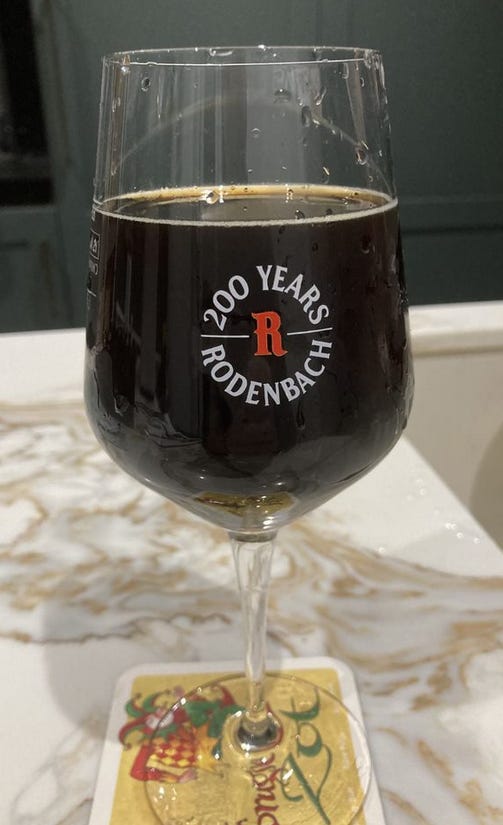Well it has been more than 18 months now since the start of this brew (see here). I did sample it about 9 months ago and decided it wasn’t quite sour enough so I left it the full term. I also took some to a CAMRA tasting tutorial session then, as an example of a sour beer… but got no real feedback when I said it wasn’t sour enough. I guess not enough folk have experience of this style of beer.
As I understand it the yeastie beasties create the alcohol at the start of the process, then the other beasties take over and generate the funkiness and sourness over time, and the longer you leave it the funkier and sourer it gets. Could be wrong. The yeast pack was called Roeselare (after the town in Flanders, western Belgium). It contains Saccharomyces cerevisiae (regular yeast), Brettanomyces (= “British fungus” known to produce funkiness), Lactobacillus (milk-souring bacteria to make yogurt), Pediococcus (another lacto souring bacteria - for sauerkraut). Presumably the exact strains are what the lambic producers get for free in the air around Roeselare!
Anyways, I bottled half of it, and added the usual half-teaspoon of Tate & Lyle to produce some bottle carbonation. Turns out that this is a big fail and learning point. I don’t think there is any (or enough) live yeast to restart bottle fermentation. I’ve left it for a month in bottle… dead flat. There is neutral yeast for cask and bottle conditioning called CBC-1, and with hindsight maybe I should have added this when priming the bottles. Still an option to empty all the remaining bottles and use CBC - but can I be bothered?
How does it taste (flat)?
It’s a deep dark red and aint bland that’s for sure - primarily winey, with plenty of funkiness and (still only) a slight sourness. A sipping beer not a guzzler.
From my limited knowledge of this style of beers it isn’t as sour or tart as a Duchesse de Bourgogne, but pretty similar to a Rodenbach - so much so that I bought the proper glass for it ! It’s the Belgian way. Except that the Rodenbach has something else - a little carbonic edge from the fizz. Maybe they gas it up from a CO2 tank?
2CBC or not2CBC? that is the question.
Another question is what to do with the other half of the batch. I have hatched a cunning plan since I bought these two little beauties:
5-litre oak casks.
Current plan is to age 5 litres in one of these for another year or so. Make another batch of Flanders Red, age it for 18 months then bottle half of it, carbing it up properly, and age the rest of *that* in oak, and have a go at the Belgian blending game. Except that I have no idea what I’m doing in blending and I’m certainly no supertaster. May need some more of these nifty oak barrels.
That still leaves 5 litres of the first batch. I’m going to fruitify it to make a fruited lambic style beer. I have loads of loganberries in the freezer (they are pretty much equal to raspberries when blitzed). I have no idea how much to use per litre. Previous fruity experiments lead me to believe that it will take huge amounts to produce a significant taste. BTW if you’re into fruity lambic beers, check the small-print on the bottles… it is highly likely that they use essences and flavourings rather than real fruit. Must be where Titanic got the idea.
Will experiment and report back in part 3. This may take some time…




